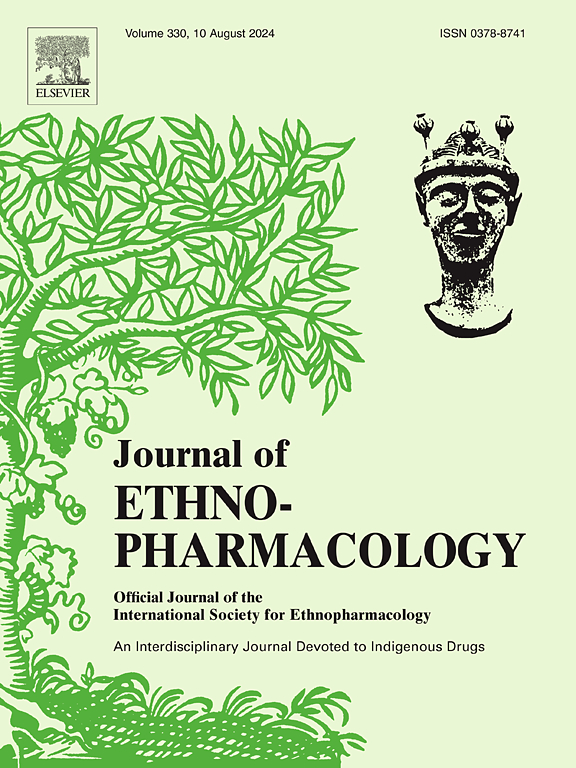Safflower yellow alleviates cognitive impairment in mice by modulating cholinergic system function, oxidative stress, and CREB/BDNF/TrkB signaling pathway
IF 4.8
2区 医学
Q1 CHEMISTRY, MEDICINAL
引用次数: 0
Abstract
Ethnopharmacological relevance
Carthamus tinctorius L. (Safflower) was believed to have multiple benefits, including antioxidant effects, enhanced learning and memory, and improving neuronal injury. Safflower Yellow(SY) are the main active ingredients of Safflower, displays strong pharmacological potential treatment of Alzheimer's disease(AD). However, its effect on memory impairments remains insufficiently investigated.
Aim of the study
The study aims to investigate the effects of SY on cognitive functions in memory impairments model and to explore the mechanism of its action.
Materials and methods
We utilized the Morris Water Maze, Step-Through Test, Step-Down Test to assess the potential of SY in ameliorating learning and memory dysfunction caused by SCOP, NaNO2 and ethanol in mice. Bioinformatic analysis and molecular biological approaches were used to study the related mechanisms of SY on anti-memory impairments.
Results
The results of the Morris Water Test suggested that SY could shorten the escape latency and the time of the first crossing platform in the mice with memory acquisition and memory consolidation impairments, and increase the platform crossing times. The results of the Step-Though test and Step-Down test showed that the escape latency in the mice was prolonged and the number of errors was reduced after SY treatment. ELISA experiments indicated that SY decreased the AChE activities, increased the ChAT activities, and modulated oxidative stress markers (SOD, MDA, and GSH-PX) in scopolamine-induced mice. Western Blot and Nissl staining showed that SY could activated BDNF/TrkB/CREB signaling pathway and reduced neuronal damage.
Conclusion
The findings present that SY can restore the function of the cholinergic system, inhibit oxidative stress, regulate the expression of upstream and downstream proteins in the CREB/BDNF/TrkB pathway, and alleviate brain tissue damage to improve memory impairment in mice.

红花黄色素通过调节胆碱能系统功能、氧化应激和 CREB/BDNF/TrkB 信号通路缓解小鼠的认知功能障碍
民族药理学相关性:Carthamus tinctorius L.(红花)被认为具有多种功效,包括抗氧化作用、增强学习和记忆能力以及改善神经元损伤。红花黄(SY)是红花的主要活性成分,具有治疗阿尔茨海默病(AD)的强大药理潜力。然而,其对记忆障碍的影响仍未得到充分研究:研究目的:本研究旨在探讨 SY 对记忆损伤模型认知功能的影响,并探索其作用机制:我们利用莫里斯水迷宫、阶梯试验、降台阶试验来评估SY在改善由SCOP、NaNO2和乙醇引起的小鼠学习和记忆功能障碍方面的潜力。采用生物信息学分析和分子生物学方法研究了SY抗记忆障碍的相关机制:结果:莫里斯水试验结果表明,SY能缩短记忆获得和记忆巩固障碍小鼠的逃逸潜伏期和第一次穿越平台的时间,并能增加穿越平台的时间。小鼠 "步步惊心 "和 "步步惊心 "试验结果表明,SY治疗后,小鼠的逃逸潜伏期延长,错误次数减少。ELISA实验表明,SY降低了东莨菪碱诱导小鼠的乙酰胆碱酯酶活性,提高了胆碱酯酶活性,并调节了氧化应激标记物(SOD、MDA和GSH-PX)。Western Blot和Nissl染色显示,SY能激活BDNF/TrkB/CREB信号通路,减轻神经元损伤:结论:研究结果表明,SY能恢复胆碱能系统的功能,抑制氧化应激,调节CREB/BDNF/TrkB通路上下游蛋白的表达,减轻脑组织损伤,从而改善小鼠的记忆损伤。
本文章由计算机程序翻译,如有差异,请以英文原文为准。
求助全文
约1分钟内获得全文
求助全文
来源期刊

Journal of ethnopharmacology
医学-全科医学与补充医学
CiteScore
10.30
自引率
5.60%
发文量
967
审稿时长
77 days
期刊介绍:
The Journal of Ethnopharmacology is dedicated to the exchange of information and understandings about people''s use of plants, fungi, animals, microorganisms and minerals and their biological and pharmacological effects based on the principles established through international conventions. Early people confronted with illness and disease, discovered a wealth of useful therapeutic agents in the plant and animal kingdoms. The empirical knowledge of these medicinal substances and their toxic potential was passed on by oral tradition and sometimes recorded in herbals and other texts on materia medica. Many valuable drugs of today (e.g., atropine, ephedrine, tubocurarine, digoxin, reserpine) came into use through the study of indigenous remedies. Chemists continue to use plant-derived drugs (e.g., morphine, taxol, physostigmine, quinidine, emetine) as prototypes in their attempts to develop more effective and less toxic medicinals.
 求助内容:
求助内容: 应助结果提醒方式:
应助结果提醒方式:


